Noraseri – Where is the Bride?
March 26, 2006
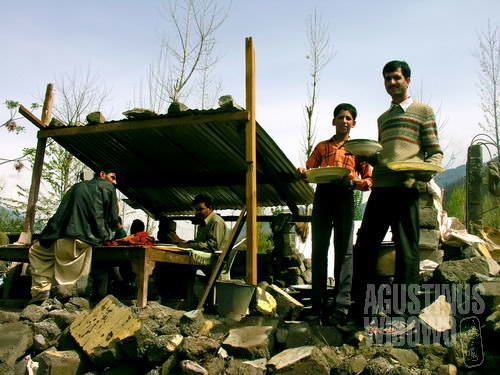
A night before I started to suspect the so-called ‘sexy gabshab’, sexy conversations of the boys, which included physical jokes like touching, hugging, and kissing. Yesterday a boy successfully reached my bed and found his way to hide under my blanket, and gave me massage. I thought it was just a normal massage of friends. But his hand always tried to guerilla to ‘that’ place. I prevented him to. And accidentally touched ‘his’ and I was surprised that he was erected. I jumped. I cursed, “Harami!”. End of joke.
It was raining the whole day yesterday. It was a sudden, like weathers in mountain areas, changed drastically in minute basis. It was terribly hot day the day before. But the radio forecast that the rain would be for three consecutive days. For sure the main road which connected the village and the outside world was blocked by the landslides.
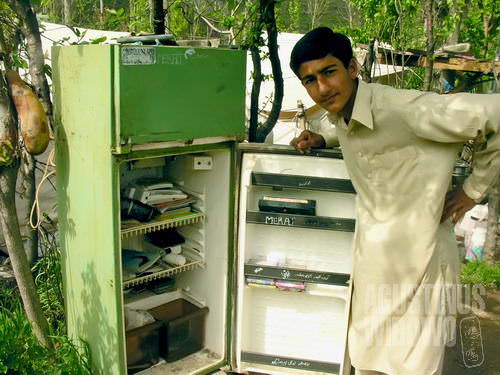
See my cupboard!
For today, after doing a short time of documentation of eighty shelter homes in Harama village (no obvious relationship with ‘Harami’), I went back to Noraseri, hearing that there would be a wedding to be held. I was invited by Vicky’s brother. Vicky was a friend of mine in the village. I expected that the wedding ceremony to be started early in the morning, but it was not until 3 pm that the activity started.
The Vicky’s relative was from the bride side. They were waiting for the groom’s barat (troupe) to pick up the bride. I saw Vicky’s father was busy of providing food to villagers. After the earthquake, the life changed to be open-air life. The kitchen was between the rubbles of the houses, on the stone bricks, and just challenging the cloud which seemly would deliver rain soon. Where was the bride? Unseen, of course. Women are in purdah, the veil, separated from the men.
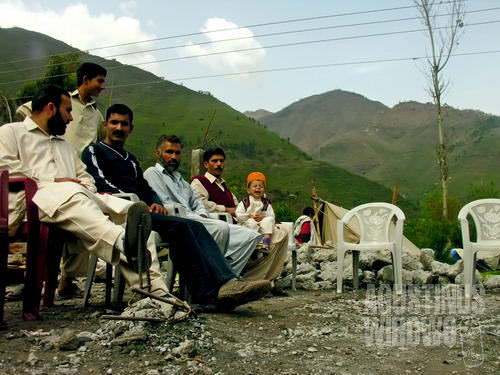
The bride family is waiting for the arrival of the groom
The food was rice with beef curry. Rice is always the favorite staple in Kashmir for parties which involved many people, or for happy occasion. And today was not excluded. White rice with black meat soup, which quite similar to nasi rawon in Indonesia, made me remember my days in my homeland. Then after food, we started to wait for the barat of the groom. As there was no huge building to wait, the visitors sit in the cricket field with chairs. One hour, two hours, no sign of troupe (barat) coming. But there was a sign of rain (baran) coming. Barat not coming yet, but baran was coming soon. The uncle of the bride was busy to prepare alternative place to house the guests from the groom’s side. A dangerously cracked-by-earthquake house was then cleaned. But it seemed that the house was too dirty and it was not ready at all to put the guests in the house.
After long waiting, the barat of the bride came. Noraseri is a village on hill slope, which cannot be reached by vehicle. The bride came from Pathika, another village near the main road of Azad Kashmir which lead to Indian border. From Pathika, the troupe came by jeeps, arrived on the hill foot of Noraseri, then climbed the hill on foot. The climbing was steep climbing, as the path was always taken by landslides which happened quite often since the earthquake.
Wedding in disaster period, the ceremony was forced to be very simple. No music, no dance, no singing. Just ceremonies. And now the rain came. The path turned to be the ugly, disgusting muddy paths. Just when the troupe of the groom, of about 50 people, reached the house of the bride, the rain had also started. The barat (groom’s troupe) came together with baran (rain). And there was no place to hide. The troupe was led by male members, and followed by colorfully dressed female visitors. I was warned by a guy, 23 years old, not to take pictures of the ladies. I never met him before. But the very same guy also said to me, pointed to a girl, that she was beautiful. I felt hypocrisy here.

The marriage is legal now
The women member of the troupe went to the house where the bride was. And the male member together with the groom went to Vicky’s simple and unfinished shelter home. Sexual segregation is the rule here. The nikah, wedding legitimation, would be held in this un-glass-windowed shelter. The rain and wind was very strong, and through the door and window holes, the water found its way to the building. The men sat making a circle. The groom, about 35 years old, white turbaned and looked quite familiar with the ceremony, seated next to the imam. The imam, collecting ID cards of the witnesses, started to write in his holy huge book of thousands pages. Then, the imam went to the bride’s room, accompanied by her uncle. I didn’t know what happened there, as I was kept in the groom’s side together with all other male members of the groom’s troupe. But I was sure that the imam was also collecting ID card information of the witnesses from the bride side.
Then the imam came back, asking for signature of the groom, and I bet that the wedding formality had been done here. After the prayer, everybody went out. The rain was not hard. But it was enough to make the white cloak of the groom dirty. Then the people went to the bride’s building. Were the male visitors going to see the bride? No. As stated before, no other males, but close relatives of the bride, might see the body, not to say the face, of the bride. Oh, except one appointed photographer (not me), and it was only for less than three minutes.
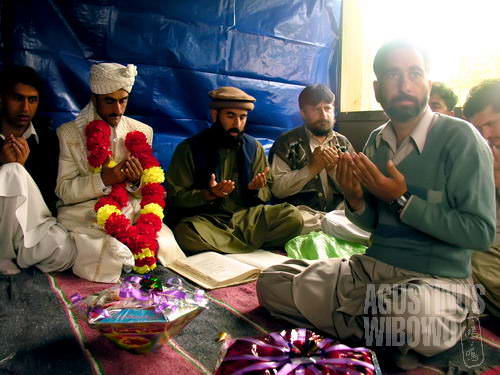
Every ritual has to be simplified in emergency earthquake zone
The guests were entertained by a simple cup of milk tea. And now was the time to pick up the bride to the groom’s side. I was expecting that the bride might be seen at this moment. But I was too confident. There was a chariot, fully completed by colorful textile and blanket, which was said to protect the bride from the ‘eyes’. This chariot is called doli. The male relatives of the bride then came into the room, along with the doli. The bride was transmitted into the doli, out of seen of unwanted men. Then the doli started to leave the house. Cried of women were heard. I didn’t know whether it was the cry of the bride or the bride’s family. As the previous Ismaili wedding in Northern Areas, this was also an arranged marriage, where the bride and groom only had seen each other before through a single photo (some years before even without photo introduction). The bride was usually felt so heavy to leave the house, where she was raised, to move to a new house with total strangers. Another rumor I have heard that the bride of this wedding was very young, not more than nineteen years old.
The doli started to move, carried by about six men from her family. The path was muddy, and there were steep slopes from the hill to reach the main road. It was not easy, and if I may say, dangerous. I slipped many times. And some of the chariot carriers were also slipped. I would felt frightened if I was the bride who was inside the doli.
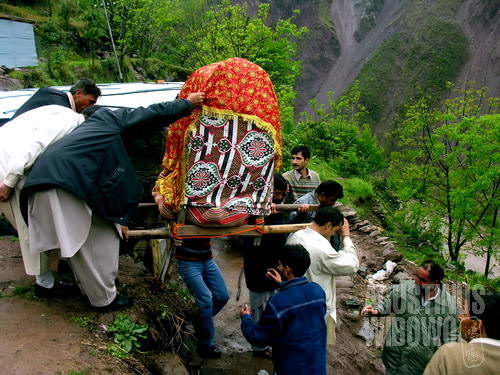
Nobody can see the bride inside that little cage
The doli was followed by the groom troupe that also returned home. There were many women in the troupe, and I was amazed that all of them, some with high heels, made it their way to go to the hill foot. Of course they slipped also. But still, they were used to handle this kind of road path. This is their habitat anyway.
According to the custom, the visit from the groom troupe (barat) should be replied by the bride troupe. The number of the members of troupes were usually equal. But due to the rainy season, and also disaster in area (not many people were interested in parties when their houses just rocked by the earthquakes), there were only 16 people (including me) to accompany the bride to go to the groom house. The people coming from the groom house are called as janji, and the people going together with the bride are called manji. So today I was a manji.
Pathika is about two kilometers away, so that jeep was essential. Now the bride reached the main road, and was ready to be translated to the jeep. Dear readers, please don’t expect me to describe the bride’s look. The bride was not to be seen. Was the whole doli, along with the bride inside, to be transported by the wedding car? No. The bride would go out of the doli and moved herself to the wedding car. Then she could be seen? No. The doli was then wrapped by blanket by the relatives, and the bride moved to the car under the blanket. Still there might be chance to peep the bride’s face from the wedding glass of the door of the car? No, the glasses were all black.
No purdah to be broken.
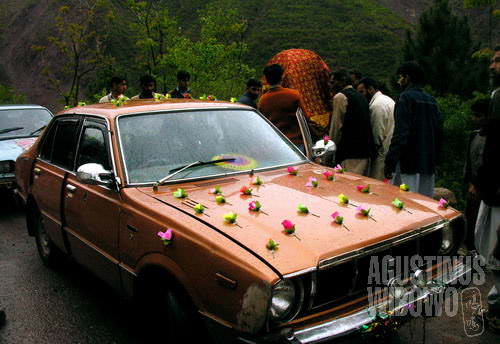
Even transferring the bride to the wedding car is also totally invisible by outsiders
The doli was then put in another jeep, where I was inside also. The journey to Pathika was merely 10 minutes, but the weather got much worse when we reached there. There was an accident when we crossed the bridge of Pathika, and there was a height limit for vehicles that could pass. The driver forgot that there was a doli chariot on his jeep, and the doli fell down. The army who was guarding the bridge was very angry. And due to the muddy road, the wedding car of the bride, a normal jeep, failed to pass after several attempts.
Now the process of bride’s translation from her car to doli was done as before, in reversed way. And she was ready to move to the wedding room. Being the sole photographer at this time, I was allowed to go to the wedding room first, and then capture the moment when the bride entered the room, out of the fully blanket-covered wedding chariot.
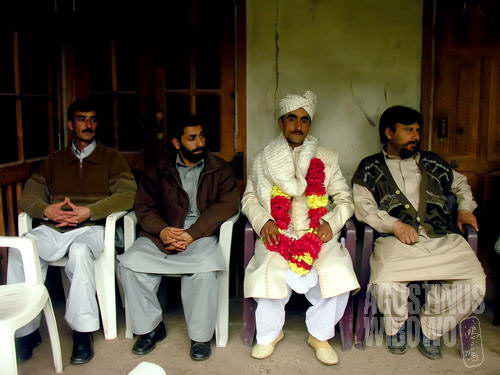
The happy groom
The bed was decorated with golden ribbons. But it was dark. There was no electricity. The bride, crying, moving out from the chariot. But despite of the non-leaking process to avoid the sight of other males, the bride was still wearing complete veil which covered her body from head to toe, so that not even a single part of body nor decoration and make-ups could be seen. I was sure that she was made-up beautifully. But it was only reserved to her husband and father, uncle, brothers, etc, and also another women.
Not only the bride who wore make-ups, the women in manji and janji all did. Remember the high heels? All of them were wearing colorful shalwar qameez, Pakistani national dress which consist of the loose shirt and boggy trousers, plus the dupata to cover the shape breast and face. When they walked on the street, only the eyes were seen. But everybody knew that under the veil, the purdah, it was hidden a beautifully decorated face.
Even the little Maryam was using perfume.






Leave a comment